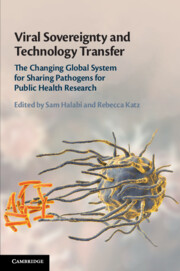 Viral Sovereignty and Technology Transfer
Viral Sovereignty and Technology Transfer from Part III - Solutions: Standard Material Transfer Agreements, Repositories, and Specialized International Instruments
Published online by Cambridge University Press: 15 May 2020
Chapter 10 “moves” the audience out of the scientific and ethical location in the theoretically low-resource but biodiverse country, and into the negotiating room where terms of sharing human pathogens occur. With decades of experience behind them, Mowatt and Ranjan cover the importance of human pathogen sharing from the perspective of the world’s most prominent biomedical research institution, the process through which sharing arises and is negotiated, the most frequent and salient barriers to sharing including isolating pathogens in the first place and then bargaining for them, mechanisms to reduce barriers to sharing including repositories and standardized agreements. Mowatt and Ranjan spend a significant amount of the chapter discussing the evolution of standardized agreements, and how those agreements functioned in recent public health emergencies including Ebola, Zika, and MERS-CoV. The authors identify common terms and conditions, disputes over publication and use of research results, rights in inventions developed during use, liability and other concerns. They provide nuance to these broad categories including the distorting influence of perceived value of material like devices or drugs, and proposed use such as discovery, pre-clinical, or clinical application.
To save this book to your Kindle, first ensure no-reply@cambridge.org is added to your Approved Personal Document E-mail List under your Personal Document Settings on the Manage Your Content and Devices page of your Amazon account. Then enter the ‘name’ part of your Kindle email address below. Find out more about saving to your Kindle.
Note you can select to save to either the @free.kindle.com or @kindle.com variations. ‘@free.kindle.com’ emails are free but can only be saved to your device when it is connected to wi-fi. ‘@kindle.com’ emails can be delivered even when you are not connected to wi-fi, but note that service fees apply.
Find out more about the Kindle Personal Document Service.
To save content items to your account, please confirm that you agree to abide by our usage policies. If this is the first time you use this feature, you will be asked to authorise Cambridge Core to connect with your account. Find out more about saving content to Dropbox.
To save content items to your account, please confirm that you agree to abide by our usage policies. If this is the first time you use this feature, you will be asked to authorise Cambridge Core to connect with your account. Find out more about saving content to Google Drive.